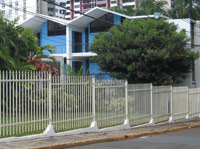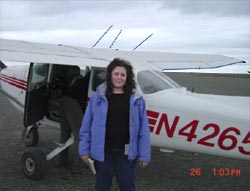About the author: Lina Younes has been working for EPA since 2002 and chairs EPA’s Multilingual Communications Task Force. Prior to joining EPA, she was the Washington bureau chief for two Puerto Rican newspapers and she has worked for several government agencies.
Lea la versión en español a continuación de esta entrada en inglés.
As we celebrate the 38th anniversary of Earth Day, I remember when I studied at the Academia San José in Puerto Rico and the events that inspired me to strive for greater environmental protection.
In the U.S. territory of Puerto Rico, a beautiful Caribbean island, one enjoys good weather all year round. Beautiful beaches, a colorful scenery, the melodious nocturnal songs of the coquí*  , the Yunque Rainforest
, the Yunque Rainforest  , the Camuy Caverns
, the Camuy Caverns  - these are some of the images and sounds that live in my memories of my island. In spite of these beautiful surroundings, Puerto Rico faces great environmental challenges-excess of solid waste, lack of landfills, trash along its beaches, problems with the quality of drinking water-these are only some of the factors that undermine its natural beauty.
- these are some of the images and sounds that live in my memories of my island. In spite of these beautiful surroundings, Puerto Rico faces great environmental challenges-excess of solid waste, lack of landfills, trash along its beaches, problems with the quality of drinking water-these are only some of the factors that undermine its natural beauty.
 When I was the president of the ASJ Science Club more than three decades ago, we were decorating an enormous bulletin board for Earth Day. We also planted a tree, I think it was an oak, in the front garden of the school. Today, 34 years later, the tree still stands-a testimony of what some students interested in sciences did one beautiful spring afternoon.
When I was the president of the ASJ Science Club more than three decades ago, we were decorating an enormous bulletin board for Earth Day. We also planted a tree, I think it was an oak, in the front garden of the school. Today, 34 years later, the tree still stands-a testimony of what some students interested in sciences did one beautiful spring afternoon.
That brings me back to today’s subject - my interest in environmental awareness. That is the seedling that I seek to plant for children and adults so that they may understand that our actions, be it at home, in school, in the community or our workplace, have an impact in our surroundings and above all in our environment. From putting aluminum cans in a recycling bin, buying green products or conserving energy, all these actions enable us to leave the world better for future generations.
Let’s celebrate Earth Day every day anywhere in the world!
*The coquí is a small frog that lives in the tropical trees and shrubs in Puerto Rico. It has been the inspiration for many songs and poetry on the Island.
Cantar del Coquí
Sobre la autor: Lina M. F. Younes ha trabajado en la EPA desde el 2002 y está a cargo del Grupo de Trabajo sobre Comunicaciones Multilingües. Como periodista, dirigió la oficina en Washington de dos periódicos puertorriqueños y ha laborado en varias agencias gubernamentales.
Mientras celebramos el 38vo aniversario del Día del Planeta Tierra, recuerdo cuando estudiaba en la Academia San José en Puerto Rico y los eventos que me inspiraron a dedicarme a la educación sobre la protección ambiental.
En el territorio estadounidense de Puerto Rico, una bella isla caribeña, se disfruta una temperatura cálida todo el año. Hermosas playas, bellos paisajes de vivos coloridos, el melodioso cantar nocturno del coquí*  el Bosque Nacional Pluvial del Yunque
el Bosque Nacional Pluvial del Yunque  y las Cuevas de Camuy
y las Cuevas de Camuy  –son algunas de las imágenes y sonidos que viven en mis recuerdos de mi Isla. A pesar de esos bellos alrededores, Puerto Rico enfrenta grandes retos ambientales-exceso de desechos sólidos, escasez de vertederos, la basura en las playas, problemas de calidad del agua potable–son tan solo algunos de factores que minan esa belleza natural.
–son algunas de las imágenes y sonidos que viven en mis recuerdos de mi Isla. A pesar de esos bellos alrededores, Puerto Rico enfrenta grandes retos ambientales-exceso de desechos sólidos, escasez de vertederos, la basura en las playas, problemas de calidad del agua potable–son tan solo algunos de factores que minan esa belleza natural.
 Cuando era la presidenta del Club de Ciencia en la Academia San José más de tres décadas atrás, estábamos preparando un enorme tablón de anuncios con carteles alusivos a la protección del Planeta Tierra. También sembramos un árbol, creo que era un roble, en el jardín al frente del colegio. Hoy, 34 años más tarde, el árbol sigue allí-un testimonio de lo que hicieron unas estudiantes interesadas en las ciencias una bella tarde de primavera.
Cuando era la presidenta del Club de Ciencia en la Academia San José más de tres décadas atrás, estábamos preparando un enorme tablón de anuncios con carteles alusivos a la protección del Planeta Tierra. También sembramos un árbol, creo que era un roble, en el jardín al frente del colegio. Hoy, 34 años más tarde, el árbol sigue allí-un testimonio de lo que hicieron unas estudiantes interesadas en las ciencias una bella tarde de primavera.
Eso me lleva otra vez al tema de hoy-mi interés en crear consciencia a favor de la protección ambiental. Esa es la semilla que quisiera sembrar para que tanto niños como adultos puedan comprender que las acciones que nosotros tomamos, sea en el hogar, en la escuela, en la comunidad o nuestro lugar de trabajo, tienen un impacto en nuestros alrededores y sobre todo en nuestro ambiente. Desde echar las latas de aluminio en la cesta de reciclaje, comprar productos “verdes” o conservar energía, todas estas acciones nos permitirán dejar un mundo mejor para futuras generaciones.
¡Celebremos el Día del Planeta Tierra todos los días en cualquier parte del mundo!
*El coquí es una pequeña rana que vive en la arboleda y flora tropicales de Puerto Rico. El coquí ha sido inspiración para muchas canciones y poesía en la Isla.


 The last time I was visiting with my family in Washington I learned that my parents decided to start making canvas shopping bags. They were noticing plastic bags everywhere littering the streets and hanging in the trees, you may have seen this in your local area, and so decided to start making the canvas bags to sell at their local store and to their friends. I have one of their bags and when people ask who made it, I get to proudly share their story of making a difference in the environment.
The last time I was visiting with my family in Washington I learned that my parents decided to start making canvas shopping bags. They were noticing plastic bags everywhere littering the streets and hanging in the trees, you may have seen this in your local area, and so decided to start making the canvas bags to sell at their local store and to their friends. I have one of their bags and when people ask who made it, I get to proudly share their story of making a difference in the environment. Before I moved to DC, I lived next to Wrigley Field, home of the Chicago Cubs. I love Wrigley Field – it’s like stepping back in time. The scoreboard is still manually operated. There are no billboards for advertising. They don’t play rock music over the PA system, though they do play polka music on the pipe organ during rain delays. You can still buy standing-room tickets at Wrigley, which is good because the seats were apparently installed when the average American was three feet tall and suffered from tapeworms.
Before I moved to DC, I lived next to Wrigley Field, home of the Chicago Cubs. I love Wrigley Field – it’s like stepping back in time. The scoreboard is still manually operated. There are no billboards for advertising. They don’t play rock music over the PA system, though they do play polka music on the pipe organ during rain delays. You can still buy standing-room tickets at Wrigley, which is good because the seats were apparently installed when the average American was three feet tall and suffered from tapeworms. When I was the president of the ASJ Science Club more than three decades ago, we were decorating an enormous bulletin board for Earth Day. We also planted a tree, I think it was an oak, in the front garden of the school. Today, 34 years later, the tree still stands-a testimony of what some students interested in sciences did one beautiful spring afternoon.
When I was the president of the ASJ Science Club more than three decades ago, we were decorating an enormous bulletin board for Earth Day. We also planted a tree, I think it was an oak, in the front garden of the school. Today, 34 years later, the tree still stands-a testimony of what some students interested in sciences did one beautiful spring afternoon.